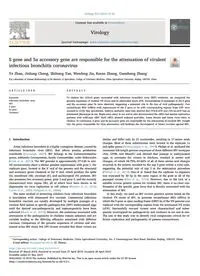
2019 S gene and 5a accessory gene are responsible for the attenuation of virulent infectious bronchitis coronavirus PDF
Preview 2019 S gene and 5a accessory gene are responsible for the attenuation of virulent infectious bronchitis coronavirus
Contents lists available at ScienceDirect Virology journal homepage: www.elsevier.com/locate/virology S gene and 5a accessory gene are responsible for the attenuation of virulent infectious bronchitis coronavirus Ye Zhao, Jinlong Cheng, Shihong Yan, Wenfeng Jia, Keran Zhang, Guozhong Zhang∗ Key Laboratory of Animal Epidemiology of the Ministry of Agriculture, College of Veterinary Medicine, China Agricultural University, Beijing, 100193, China A R T I C L E I N F O Keywords: Infections bronchitis virus IBV S gene 5a gene Virulence A B S T R A C T To explore the critical genes associated with infectious bronchitis virus (IBV) virulence, we compared the genome sequences of virulent YN strain and its attenuated strain aYN. Accumulation of mutations in the S gene and the accessory gene 5a were observed, suggesting a potential role in the loss of viral pathogenicity. Two recombinant IBVs (rIBVs) with replacement of the S gene or 5a with corresponding regions from aYN were rescued to verify this speculation. Embryo mortality time/rate showed that rYN-S-aYN and rYN-5a-aYN had an attenuated phenotype in ovo. Replication assay in ovo and in vitro demonstrated the rIBVs had similar replication patterns with wild-type rIBV. Both rIBVs showed reduced mortality, tissue lesions and tissue virus titers in chicken. In conclusion, S gene and 5a accessory gene are responsible for the attenuation of virulent IBV. Insight into the genes responsible for virus attenuation will facilitate the development of future vaccines against IBV. 1. Introduction Avian infectious bronchitis is a highly contagious disease, caused by infectious bronchitis virus (IBV), that affects poultry production worldwide (Cavanagh, 2007). IBV belongs to the Gammacoronavirus genus, subfamily Coronavirinae, family Coronaviridae, order Nidovirales (Cook et al., 2012). The IBV genome is approximately 27.6 kb in size. All coronaviruses share a similar genome organization with gene 1, the replicase gene, located at the 5ʹ end of the genome and the structural and accessory genes clustered at the 3ʹ end, which produce the spike (S), membrane (M), envelope (E), and nucleocapsid (N) proteins. IBV also possesses two accessory genes, gene 3 and gene 5, and the recently characterized inter region (IR), all of which have been shown to be dispensable for virus replication in cell culture (Bentley et al., 2013; Casais et al., 2005; Hodgson et al., 2006). The main method of protecting chickens from infectious bronchitis is inoculation with attenuated live vaccines. Commercial infectious bronchitis vaccines are usually developed by multiple passages of a virulent field isolate in specific-pathogen-free (SPF) embryonated eggs until the desired non-pathogenicity and immunogenicity have been achieved (Bande et al., 2015). However, the mutations associated with attenuation of the pathogenicity in chickens remain unknown and are variable leading to the differing efficacies associated with different vaccines. Comparison of the genome sequences of virulent and atte- nuated avian IBV strain Ark DPI viruses revealed that these viruses are similar and differ only by 21 nucleotides, resulting in 17 amino acids changes. Most of these substitutions were located in the replicase 1a and spike genes (Ammayappan et al., 2009). Philips et al. analyzed the consensus full-length genome sequences of three different IBV serotypes (Ark, GA98, and Mass41) and showed that passage in embryonated eggs, to attenuate the viruses in chickens, resulted in amino acid changes, of which 34.75%–43.66% of all of these amino acid changes occurred in the protein encoded by the nsp 3 gene within a virus type, suggesting the potential role of nsp 3 in the attenuation procedure (Phillips et al., 2012). Huo et al. found that the replicase 1a sequence was truncated by 30 bp in the same region of the gene in all of the passaged viruses (Huo et al., 2016). However, due to the lack of a suitable reverse genetic system for virulent IBV, there is no clear con- firmation of the specific gene locus that is directly associated with the attenuation of IBV. In this study, we used an IBV reverse genetics system based on the virulent YN strain of IBV, to generate recombinant IBVs (rIBVs) in which the S gene or open reading frame (ORF) 5a of the YN genome was replaced with the corresponding regions from the attenuated YN strain (aYN). Successfully rescued viruses were characterized and subse- quently investigated for pathogenicity and virulence in ovo and in vivo. The aim of this study was to identify viral components critical for ef- ficient replication and pathogenicity of gamma coronaviruses. https://doi.org/10.1016/j.virol.2019.04.014 Received 27 March 2019; Received in revised form 27 April 2019; Accepted 29 April 2019 ∗ Corresponding author. College of Veterinary Medicine, China Agricultural University, No. 2 Yuanmingyuan West Road, Haidian, Beijing, 100193, China. E-mail address:
